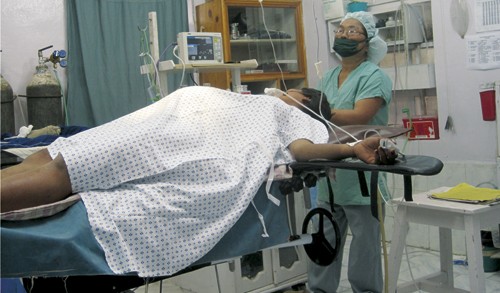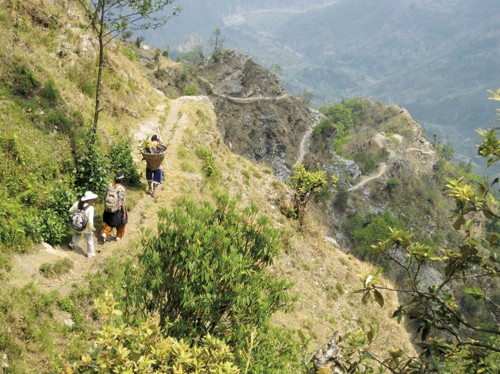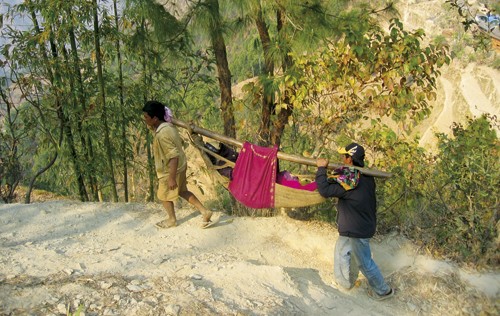It has always been dangerous to become a mother. The great majority of maternal deaths could have been avoided if simple antenatal and birth care had been available.

Preparations are made for Caesarean section. After four days in labour, there is a risk of uterine rupture. The patient has consented to publication of this picture. All photos Erik Bøhler
The maternal mortality in the world as a whole is still 397 per 100 000 births (1). In comparison, the maternal mortality in Norway has fallen in the course of some decades to seven per 100 000 births (2). In countries like Nepal one in four women go through the whole pregnancy without any form of antenatal checks, and only 19 % of births take place with a trained birth assistant present (3). Here is a true medical history that illustrates some of the differences in birth care between Norway and Nepal.
As it is now free of charge to give birth in the hospital in Okhaldhunga in the rural district of Nepal (4), and roads are being made to an increasing number of villages, we now come into contact with many women who would have otherwise been part of the sad statistics. I recently met one of them.

Women in labour are carried along these paths to the hospital
Complicated birth
She is 17 years old and pregnant for the first time. She had not been to any antenatal checks during her pregnancy. She is young and strong, and the family thought that it would be straightforward to give birth at home. She does not live in Okhaldhunga, but in a neighbouring district where there is no functioning hospital. It was so far to the nearest hospital that the family preferred to manage by themselves. It went wrong. The birth started, but the baby did not come out. The girl was in increasing pain, and at last they walked for some hours during the night to the nearest road, and then paid 5000 rupees (= just over a month’s wages in the village) for car transport to the hospital in Okhaldhunga.
She arrived at the hospital four days after the birth started. On arrival she was exhausted, in pain, and only just managed to answer questions. She had not slept for four days and almost not eaten. The pregnant abdomen was «odd» to palpate, and the child’s head had not yet descended into the pelvis. The old ultrasound machine in the labour ward is still in use. When we turned on the machine we saw at once that something was wrong. The fetus had massive hydrocephalus and only a thin rim of brain tissue was visible. The baby was moving and the heart was beating. The biparietal diameter was 143 mm, or about 150 % of the upper normal range for Nepali fetuses at term (5). It was obvious that vaginal birth was impossible. Children with congenital hydrocephalus have no chance of survival in Okhaldhunga. The child was still alive. We explained to the family that the child would die, but that we would do what we could to ensure that the mother survived. Even this was not certain. With such massive hydrocephalus it is technically difficult to extract the head from the uterus by Caesarean section. If the child had been dead we would have tapped water out of the head before we extracted it. But it feels impossible to do this on a child that is alive.
It was a complicated Caesarean section. It was not possible to manipulate the head out with a normal transverse incision in the lower uterine segment. The incision cannot be prolonged very far laterally, because of the risk of haemorrhage from large blood vessels, so we extended it with a longitudinal incision up the midline, like an «inverted T». It was only then that we managed to extract the enormous fetal head. The child was not capable of survival and died a few minutes after delivery. Attempts at resuscitation were not carried out, in line with a decision made in advance. The over-extended uterus was bleeding severely, but was eventually contracted by manual compression, oxytocin, ergometrine and misoprostol.

Normal method of transport for women in labour who come from far afield to the hospital in Okhaldhunga
The hospital has no blood bank, but an uncle accompanying the patient had the correct type of blood, and she was given one unit of blood from him during the operation. Broad treatment with antibiotics was started immediately. She had a high temperature during the first two days after the operation, otherwise there were no complications.
The operation has given her a vertical scar in her uterus, from the lower segment and up into the body of the uterus. With a scar like this she must never give birth vaginally as there is a great risk of rupture. She is in her late teens and married to a boy of her own age. They live very far from a hospital, so next time she becomes pregnant she must come to the hospital?s waiting home for pregnant women during the last weeks before delivery, so that she can be certain of receiving help at the right time. They understand the situation now. But will they remember it, and will they be able to afford it next time she becomes pregnant? It is still dangerous to become a mother.